



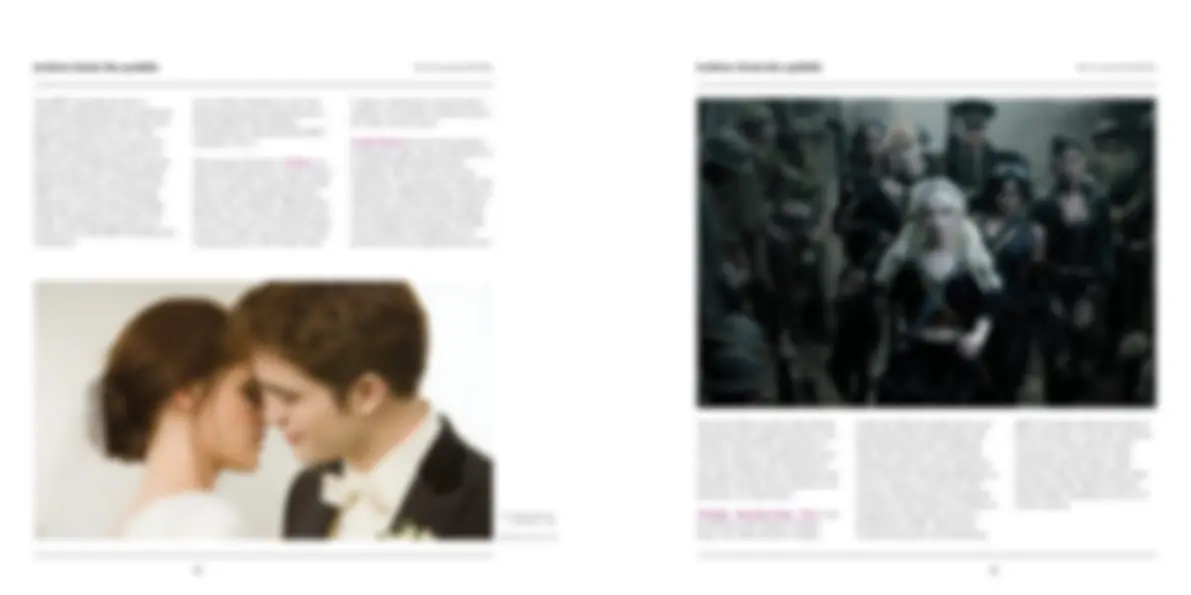
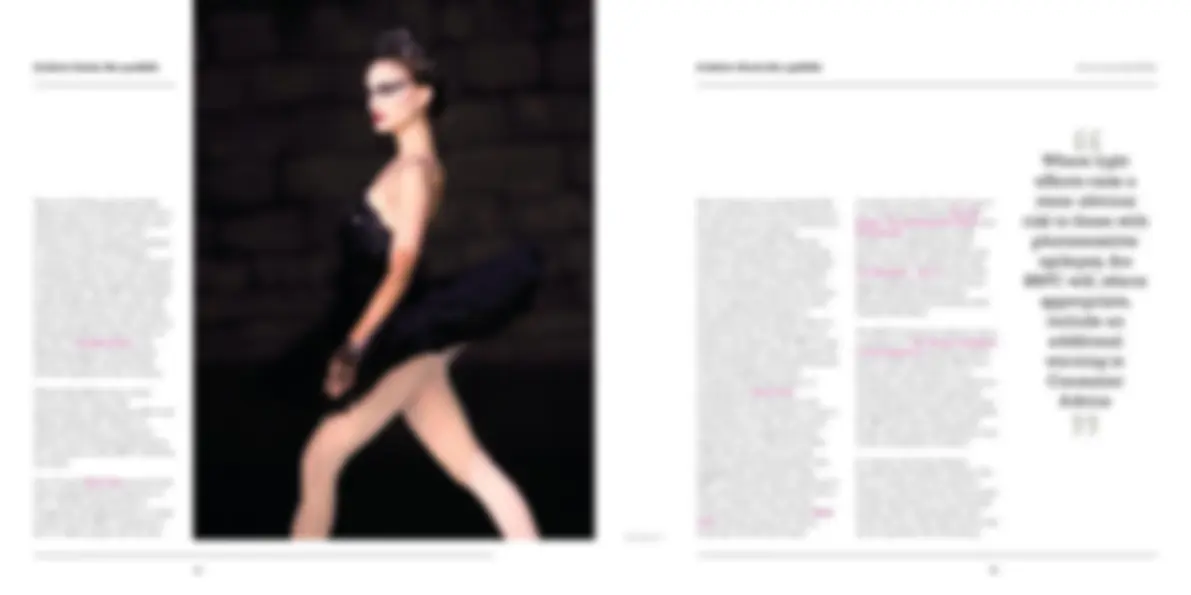
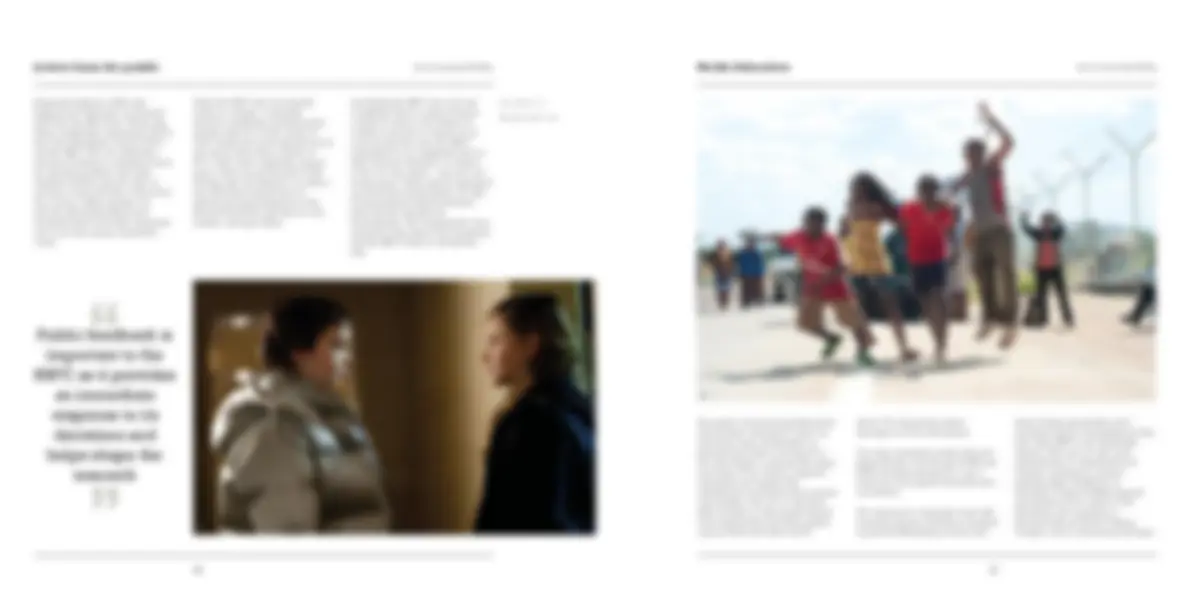
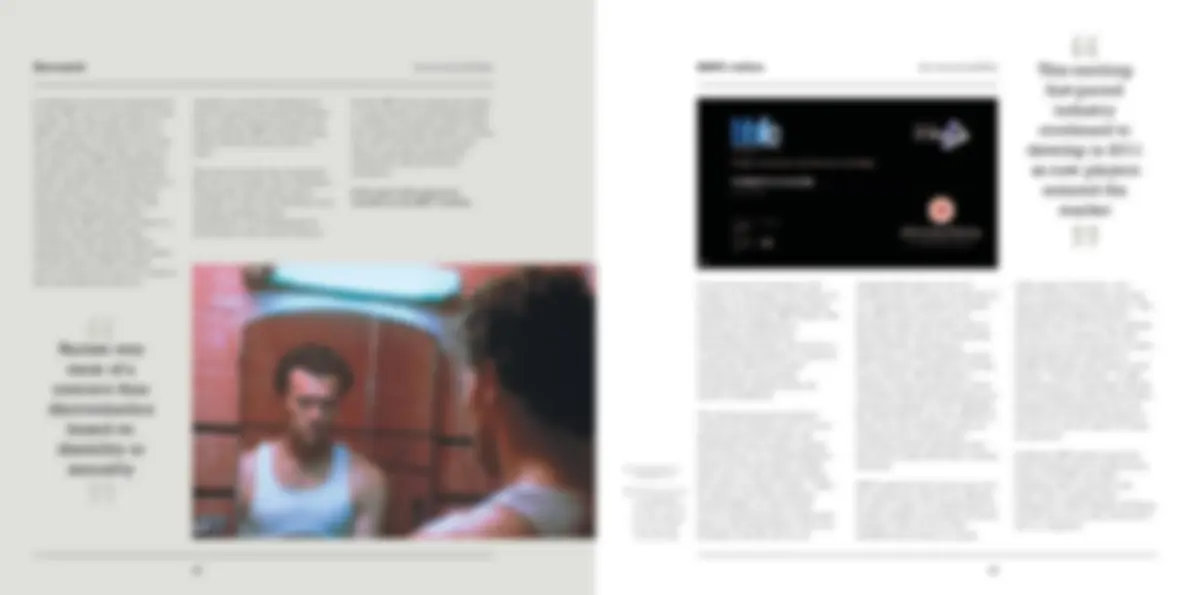
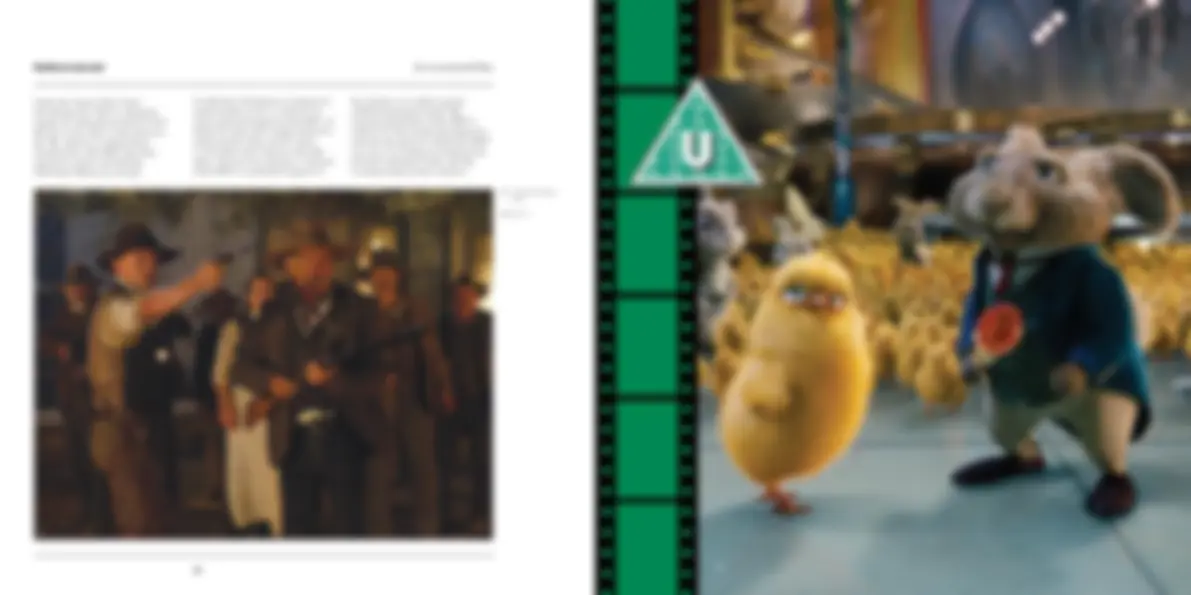

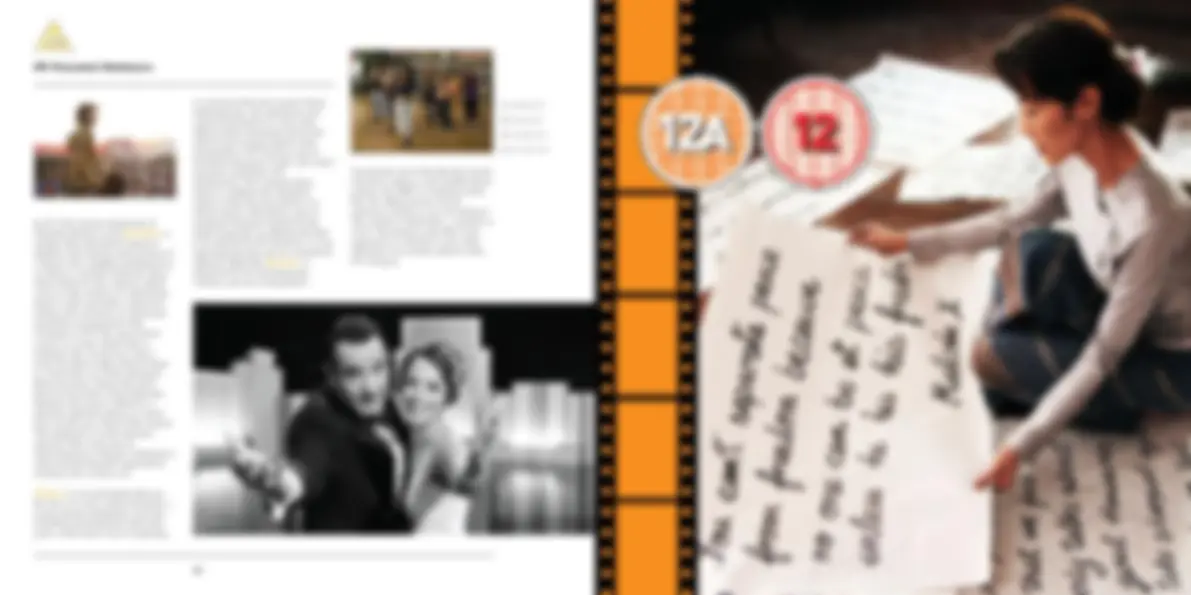
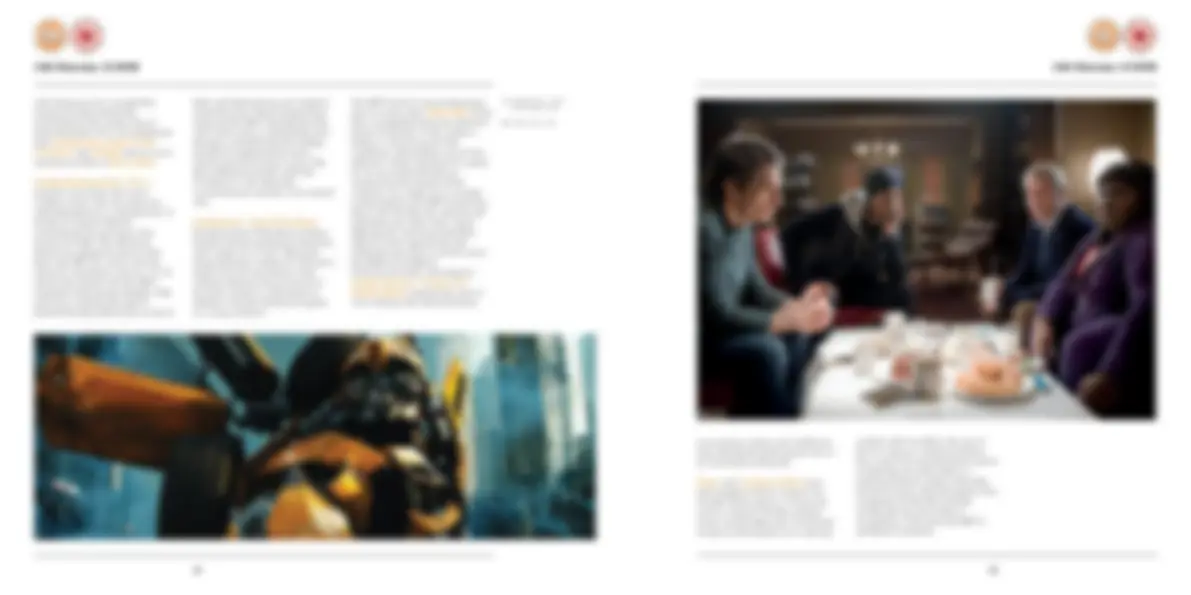





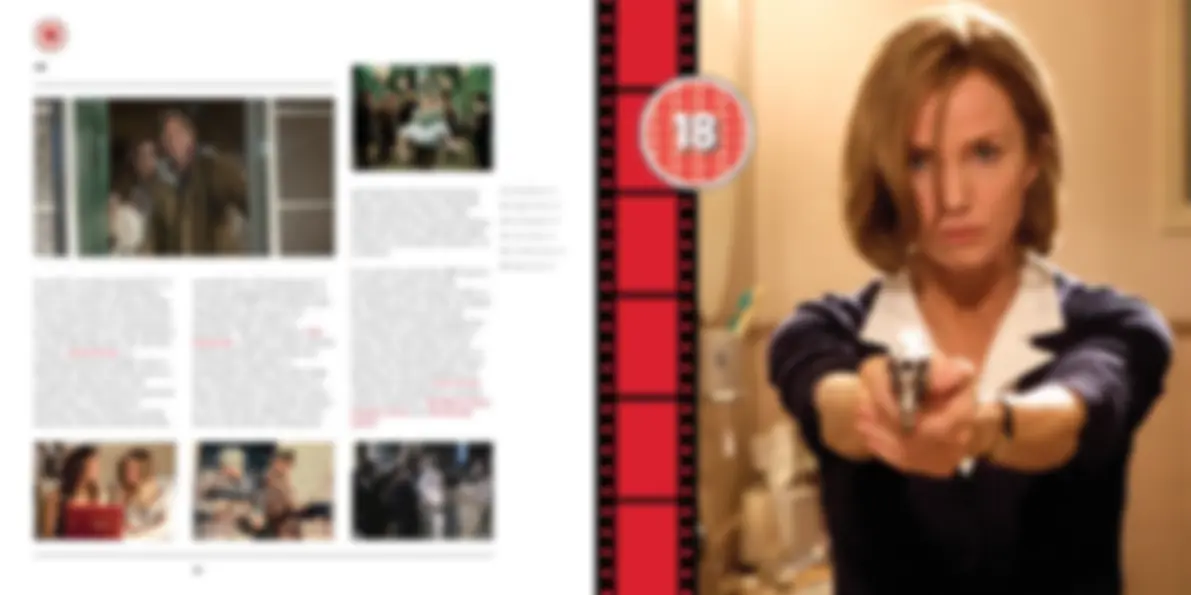
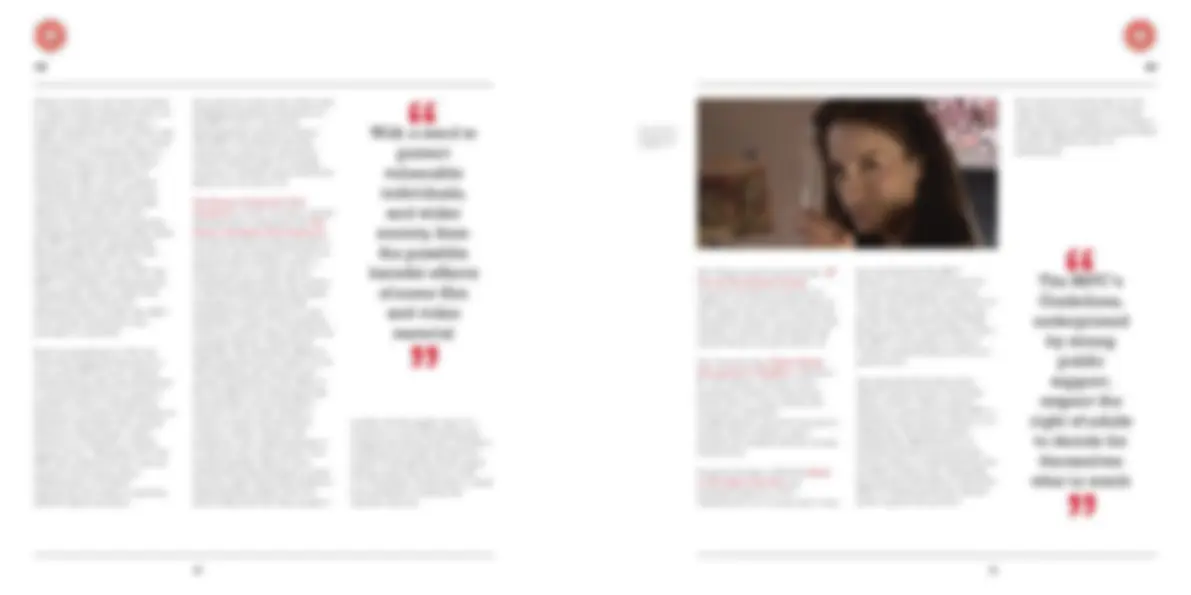


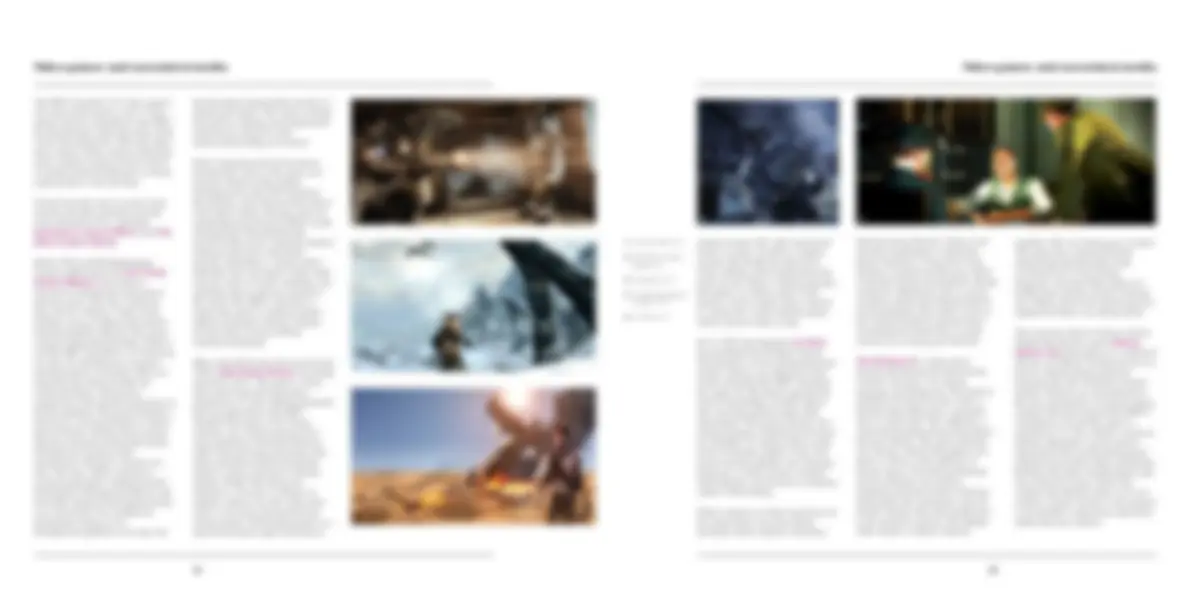


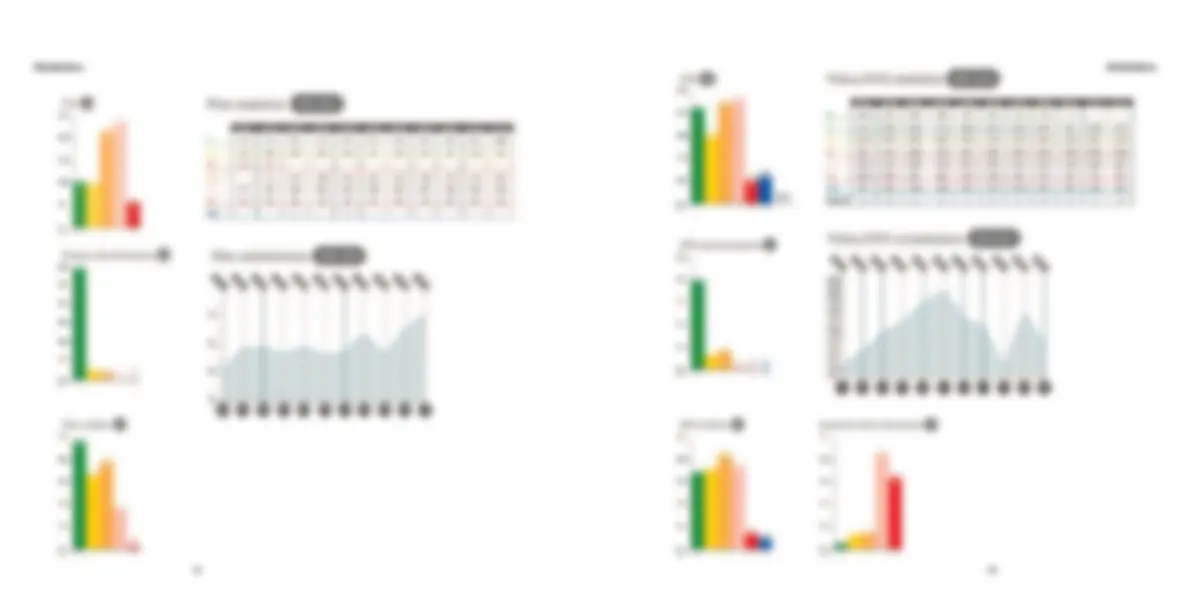

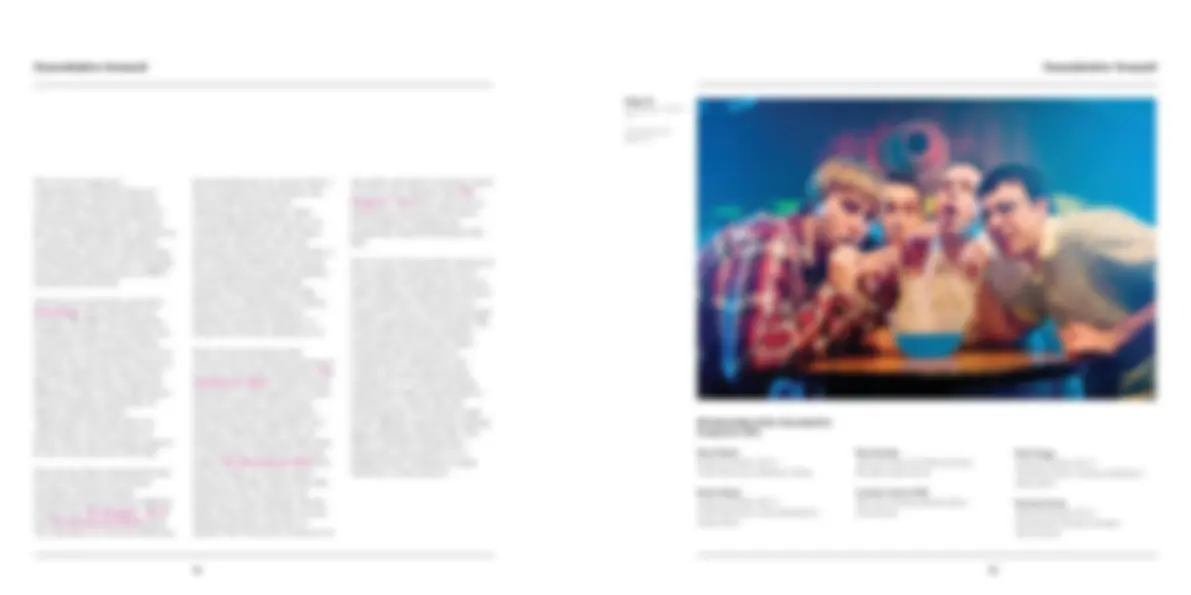

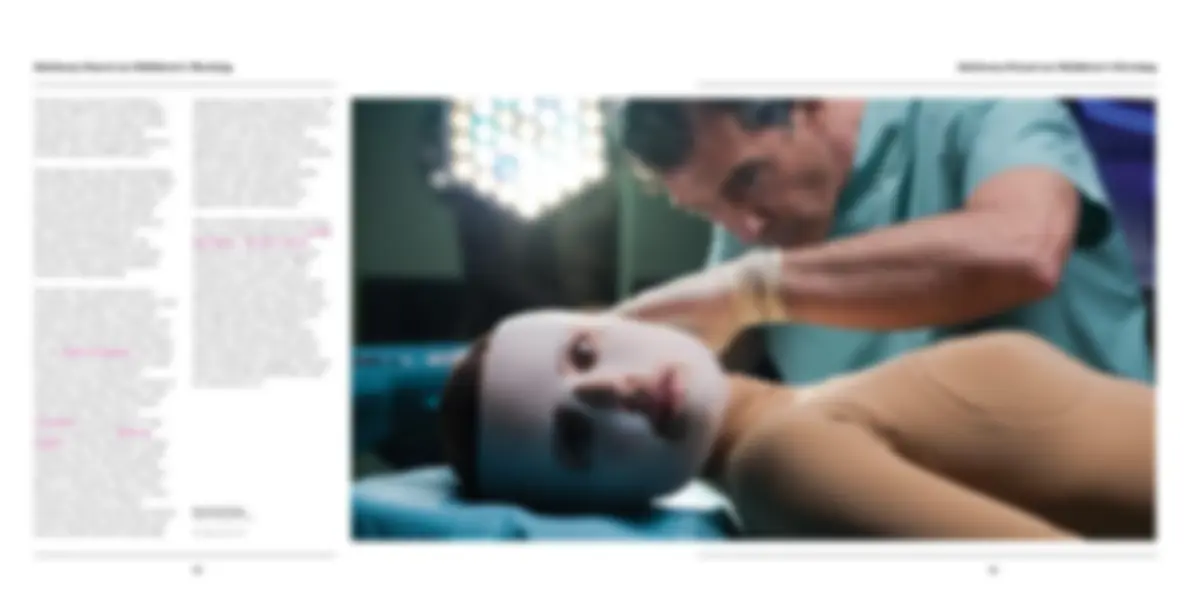
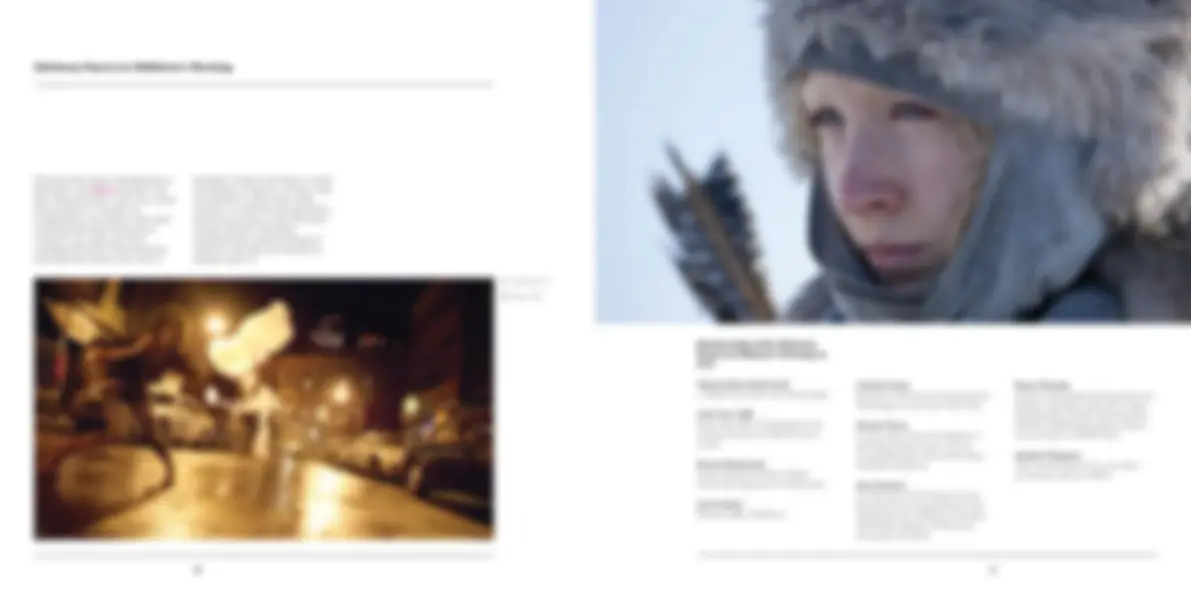















Study with the several resources on Docsity

Earn points by helping other students or get them with a premium plan


Prepare for your exams
Study with the several resources on Docsity

Earn points to download
Earn points by helping other students or get them with a premium plan
Community
Ask the community for help and clear up your study doubts
Discover the best universities in your country according to Docsity users
Free resources
Download our free guides on studying techniques, anxiety management strategies, and thesis advice from Docsity tutors
The importance of BBFC film classifications in the digital age, with statistics on parental usage and consumer preference. It also covers BBFC's accountability, handling of complaints, and initiatives like the publication of a BFI book and the BBFC's 100th birthday celebration. The document also mentions BBFC Director David Cooke's blog posts and increased Twitter activity.
What you will learn
Typology: Exercises
1 / 50

This page cannot be seen from the preview
Don't miss anything!











































My Week With Marilyn ‘15’
Presented to Parliament pursuant to Section 6(2) to the Video Recordings Act 1984
Meeting consumer demand One of the key pieces of legislation which governs the work of the BBFC – the Video Recordings Act – is now over a quarter of a century old. It predates the technological revolution which has led to the multiple delivery channel world in which we live.
So 2011 seemed like a good time to ask the British public what value they placed on the BBFC in the digital world. Is there a role for the BBFC and, if so, what should it be?
Independent research carried out in June 2011 demonstrated conclusively that the public values what we do to bring content advice online. That research showed that while the public considers that the internet brings greater choice, freedom and flexibility, the majority of viewers still consider it important to be able to check the suitability of audio-visual content they download. As more viewing takes place online, consumers expect that the same level of BBFC support will apply online as currently applies offline. 85% consider it important to have consistent BBFC classifications available for VOD content, rising to 90% of parents of children under 16. 89% of parents check BBFC classifications on films
that they and their children download, even though this is not always easy to do. 82% of parents with children under 16 prefer to download films which carry a BBFC online classification over those films which do not. 92% of those who regularly download films find BBFC ratings and content advice useful.
This view is echoed by the home entertainment industry. David Cooke touches on this in his introduction, but I’d like to share one comment made by a distributor which gets its online content classified by the BBFC on a best practice, voluntary basis: “ what matters is that the BBFC is there to inform people about content … that is
more and more important to the online world ”.
Government initiatives 2011 has been a busy year in terms of Government initiatives. Since January, the BBFC has contributed to several Government consultations or Parliamentary Inquiries. These include the Communications Act consultation where we, alongside others concerned with the home entertainment, film and other online industries, urged Government to support existing best practice self regulation in the online space. We gave evidence to the Parliamentary Inquiry into Child Protection online on the successful partnership between
the BBFC and the home entertainment industry which is increasingly leading to trusted BBFC symbols and content advice being attached to material being distributed online.
We contributed to the Licensing Act consultation launched by John Penrose MP, Minister for Tourism and Heritage at the Department for Culture Media and Sport, in the autumn. We worked closely with cinema exhibitors and film distributors on a sensible way forward and we, the FDA and CEA jointly recommended to Government maintaining the current licensing regime with some minor amendments. We all believe that the current Licensing Act offers the best statutory mechanism to: maintain child protection; ensure a continued role for local authorities as the enforcement body and appeal mechanism for BBFC classifications; enable exhibitors and distributors to get films to market efficiently and in a properly regulated safe environment for the public.
We also responded to the Government’s consultation on Suicide Prevention in England and Wales. Working closely with bodies such as The Samaritans, the BBFC ensures that depictions of suicide and self harm
are appropriately classified to keep potentially harmful content away from impressionable children and young people.
In partnership with other regulators and the music industry, the BBFC has been working towards implementation of Reg Bailey’s Review into the Commercialisation and Sexualisation of Children. First, working with Ofcom and others, we jointly set up a website
The music video issue has been given more impetus by the promised DCMS consultation on exempt video works, due to be launched in 2012. We, the British Video Association, British Phonographic Industry, the Video Standards Council and the Local Government Association support a technical adjustment to the Video Recordings Act whereby content in exempt videos which is potentially harmful to children should lose the video its exemption and require it to
receive an enforceable BBFC classification to keep it away from vulnerable and impressionable children.
Sexual violence Along with strong language, sexual violence was one of the key classification themes of 2011. The issue of sexual or sexualised or sadistic violence, usually but not always directed against women, continued to be a feature requiring careful attention in works submitted to the BBFC. The BBFC has a robust policy on depictions of sexual violence in films and videos. It will refuse to certify any content which endorses or eroticises sexual or sexualised violence.
In 2011, two works in particular attracted controversy because they featured extreme violence against women. The BBFC considered The Human Centipede II (Full Sequence) (in which a man achieves sexual gratification from the stapling together of victims to form a human centipede and which culminates in him raping a woman with barbed wire) and The Bunny Game (in which a truck driver abducts, strips and sexually abuses and tortures a prostitute).
President’s Introduction President’s Introduction
The BBFC intervened with both of these works. It made significant cuts to The Human Centipede II (Full Sequence) and refused to certify The Bunny Game because of the harm risk both works pose. It is illegal to supply the uncut version of The Human Centipede II (Full Sequence) and any version of The Bunny Game in the UK.
Partly as a result of these and other films, the BBFC is commissioning a major new piece of original research into depictions of sadistic, sexual and sexualised violence, mainly against women, to determine what the British public today believes is potentially harmful and therefore unacceptable for classification. The research will be completed in 2012 and the BBFC will publish it given that it might be helpful to other regulators.
Hail and farewell In 2011, the BBFC welcomed an entirely new Video Appeals Committee chaired by Professor Andrew Burrows. I should like to offer my thanks to the outgoing Chair, John Wood, and his colleagues for their work over many years. They offered a model of complete integrity and independence.
The BBFC also welcomed a number of new members onto its Consultative
Council. These include representatives of parents groups, such as Reg Bailey of the Mothers Union, and Justine Roberts of Mumsnet. They include representatives of law enforcement agencies; local government; fellow media regulators, including Ofcom and the ASA; and industry, including the FDA and CEA.
We said goodbye to a number of Consultative Council members: Colin Webb, Colin Munro, David Buckingham, Maurice Mills, Tony Beech, Andy Shortland, Gery McLaughlin, Goronwy Parry and Mike Rawlinson. I am most grateful for their contributions over the past few years and wish them well in the future.
As always, it has been good to work closely with Graham Lee, who chairs the Council of Management, Steve Jaggs its Vice Chairman and our other colleagues on that body.
Finally, I should like to record my thanks to the Director, David Cooke, for his enthusiastic and effective support to the Presidential team, and indeed to Council, and for his direction and leadership of the Board's work as a whole. Without him, and his able team of colleagues, none of this would be possible.
Look forward to 2012 2012 is a big year for the BBFC. It’s our centenary. We are planning a number of events to mark the occasion. These include exhibitions, and an international conference. Regular cinema goers will have been seeing from 1 January a series of black card designs based on the classic BBFC black cards through the century starting with our pre-First World War certificate. Film fans will be interested in a BFI book, part history, part forward look, about the BBFC to be published in the autumn to coincide with a BFI-organised season of controversial films.
So 25 years on from the Video Recordings Act, we have a great deal to look forward to. Continued high levels of trust from the public. Ever deepening levels of cooperation with the film and home entertainment industries, both offline and increasingly in online partnerships. And a year long celebration of film and the BBFC’s role and that of its dedicated and expert staff past and present, in this major creative industry.
Quentin Thomas, 2012
Higher film submissions; lower video submissions 2011 was another successful year for film, during which we classified 710 films for theatrical release. An increase of 56 features, or 8.5% over
Meeting the changing needs of industry As the BBFC approached its centenary in 2012, I considered that 2011 would be a good time to consider where we are and how we have changed over the years to take account of shifting social attitudes –
reflected in our Classification Guidelines – but also a rapidly changing film and home entertainment industry.
So we asked both the public and the industry what they wanted from the BBFC. Quentin Thomas discusses the results of the public consultation. It’s right that I consider the industry’s responses given my daily relationship with our customers, both large and small.
In June 2011, we commissioned research into our customers’ needs. The research was well-received and the results showed very positive industry perceptions of the BBFC which have been improving over time. To build on this, we drew up Action Plans which we are implementing to improve the service we offer our customers even further.
Industry told us that they need ever faster turnaround times. So during
President’s Introduction Director’s Report
The Board’s main website, www.bbfc.co.uk, provides information about all the works classified by the BBFC, including Consumer Advice and Extended Classification Information (ECI). ECI consists of detailed information about the content of the work and the rationale for the classification decision.
Consumer Advice is provided for all films, video and video game works classified by the BBFC. Consumer Advice briefly describes the content which determined the classification of a work and highlights particular issues such as sex, violence and language. Extended Classification Information (ECI) is available for every film and video game classified since Autumn 2007. ECI gives a more detailed account of the classification issues in the work and any additional elements that might be of interest to the potential audience, particularly parents.
Consumer Advice and ECI for films and video games, and Consumer Advice for DVDs, is also available via the free BBFC App, for iPhone, iPod Touch and Android devices.
To engage still further with the public in 2011, the BBFC began blogging on the new Huffington Post UK website, which launched in July. BBFC Director David Cooke published six blog posts from July to December covering issues including film rejection; classifying sex across the age categories; the BBFC’s education programme; and the BBFCs voluntary online film labelling service.
In October, the BBFC launched a regular podcast to discuss recent classification decisions and major classification themes. Listeners can actively engage in the podcast by emailing their questions and comments to podcast@bbfc.co.uk. BBFC activity on twitter also increased in 2011. The @BBFC twitter account, originally set up to tweet film classification decisions, is now used to tweet all press releases, BBFC education visits, new case studies, and other classification news relevant to the public and film and video industries.
Consumer Advice and Extended Classification Information Accountability
The BBFC is accountable to both the public and Parliament. It takes this accountability seriously. This Annual Report is a key part of its fulfilment of this requirement. It provides a review of the activities and classification decisions of the Board over 2011 as well as information about our financial position as required by law. Our Reports are posted onto our websites and are placed in the libraries of both Houses of Parliament.
The BBFC views providing the public, especially parents, with detailed and accessible information about the works it classifies as another essential element of its function and accountability. This information is published on the BBFC’s websites, and enables parents and other viewers alike to make informed choices about what they and their families watch both at the cinema and in the home.
Accountability
the level of threat aimed at the female characters. The implication that in one of Baby Doll’s fantasy worlds she is forced to work in a brothel drew most criticism. However, the treatment of this aspect of the film is restrained and relatively discreet and not shown to be glamorous or aspirational.
Twilight - Breaking Dawn – Part 1 , the fourth film in the popular Twilight Saga, sees Bella and her vampire
boyfriend, Edward, finally marry and consummate their relationship. The film generated sixteen complaints. Only a few of these concerned the wedding night sex scene, which had been reduced in strength, following an advice viewing, to secure the 12A category. The majority of complaints focussed on the sequence in which an emergency Caesarean section is performed on Bella, which some viewers found gory and distressing.
Letters from the public
The BBFC generally receives a relatively small number of complaints about its classification decisions and this trend continued in 2011. The BBFC responds to every email and letter providing the rationale for its decision and addressing any specific points raised by the correspondent. Public feedback is important to the BBFC as it provides an immediate response to its decisions and helps shape the research and large scale public consultations carried out at each review of the BBFC Classification Guidelines.
A trio of films classified at 12A and featuring young but strong heroines facing difficult, albeit fantasy, circumstances, dominated the BBFC ‘postbag’ in 2011.
The teenage character in Hanna is a genetically engineered ‘super soldier’ sent on a quest to avenge the murder of her mother. The film generated twenty-nine complaints. Although the film has a clear action adventure and sci-fi context, some viewers found the violence sadistic and gratuitous. That a teenage girl is at the centre of the
violence, despite her ‘super human’ abilities, was another troubling aspect for some cinema goers.
Sucker Punch sees its young female protagonist, Baby Doll, incarcerated in a mental health hospital by her stepfather who wants to claim her inheritance. To escape her ordeal, she retreats into different fantasy worlds in which she, and other female inmates, are empowered as warriors battling robot soldiers and dragons. The film received fifteen complaints for its perceived sexual suggestiveness and
Letters from the public Accountability Accountability
1 Twilight Breaking Dawn Part 1 ‘12A’ 2 Sucker Punch ‘12A’ 1
2
BBFC Guidelines allow brief sight of blood and gore at 12A. The operation occurs out of shot and the scene concentrates on the faces of the characters and the drama of the situation, rather than the detail of the procedure, while elliptical editing echoes Bella’s slipping in and out of consciousness.
While the BBFC does not classify works as ‘exempt’, it regularly receives complaints questioning the exempt status of a wide variety of video works and criticising the lack of any advice about their content. In 2011, there were complaints against music videos by artists such as The Flaming Lips and Beyoncé, as well as sex education material used in schools and documentaries on the Second World War and famous train crashes, amongst others.
Letters from the public Accountability
1 Let Me In ‘15’ 2 Africa United ‘12A’
And finally, the BBFC also receives complaints about a range of issues outside its remit, or for which it is unable to provide an answer. In an unusual case this year, the BBFC responded to six complaints about a film it had not classified, or indeed – as far as it was aware – was not even being made. Online reports appeared provocatively around Easter of a film being produced which portrayed Jesus and his disciples as homosexuals. The complainants were incensed at this report and requested that the BBFC refuse to classify the film.
Standards Authority (ASA), the Authority for Television on Demand (ATVOD), the BBC Trust, Ofcom, the Press Complaints Commission (PCC), the Video Standards Council (VSC) and the BBFC. The site makes the process of making a complaint easier by directing parents to the right regulator for their specific area of concern. It also provides a ‘Have Your Say’ section, where parents can provide informal feedback and comments that each of the regulators use as an extra gauge of parental views.
1
The public, educational professionals and students continued to value our education work, and therefore to demand more from us during 2011. We were happy to increase the range and scope of our work to empower consumers and explain film classification to students, their parents and teachers. Part of our education effort touches on why people should view legal product and shun pirated copies of favourite films and TV
shows. We will continue these messages in 2012 and beyond.
Our main customers remain Film and Media Studies, A Level and GCSE and BTEC students, though 2011 saw a conscious and targeted diversification of audience.
We continued to undertake work with university groups, both those engaged in practical filmmaking courses and
those looking specifically at the academic study of censorship and the role of the BBFC in the British film industry. This year we also gave presentations on classification for younger audiences to groups studying Early Childhood, at University Campus Suffolk, Ipswich and introduced our work to CGI Animators and visualisers at Bournemouth and Poole College Campus, and to international students
Media Education Accountability
2
Education team members also travelled to several arts and film festivals, with first time visits to the Hay Literary Film Festival (to talk with school groups in partnership with Film Club) and the Foyle Film Festival in Northern Ireland where we gave a series of tailored events on classifying true stories and documentaries, and a masterclass on The Boy in the Striped Pyjamas. We also presented sessions at the Cinemagic International Film and Television Festival For Young People in Belfast, the Glasgow Youth Film Festival and the Zoom Film Festival in Pontypridd.
Our long lasting relationship with Film Education continued. The highlight was our contribution to National Schools Film Week. Examiners gave masterclasses on classification in 14 cities in England, Scotland and Wales, to both primary and secondary students. Primary school audiences viewed The Secret of Kells , while secondary school students discussed Black Swan , Attack the Block , Let Me In , 127 Hours and Winter’s Bone. Resources on all these films were made available to teachers and published on our education websites.
Media Education Accountability
at the Institute of European Studies (IES) in Bloomsbury. 2011 also had an international flavour as we spoke to international delegates studying Film, Governance and Society and media students from Voss Husflidskule in Norway. Collaborations with arts venues across the UK included work
at Edinburgh Filmhouse, Manchester Cornerhouse, Warwick Arts Centre, Cinema City in Norwich and the Robert Burns Centre in Dumfries, presenting all-day study sessions on specific films, such as Africa United , Kick-Ass and Let Me In , and participating in A Level conferences
and open lectures for members of the public. Outside the school terms, we worked at a grassroots level with youngsters starting out in the film industry, running sessions at three of the Co-operative British Youth Film Academies during the summer.
Media Education Accountability
1 Kick-Ass ‘15’ 2 Attack the Block ‘15’ 3 The Secret of Kells ‘PG’ 1
2
3
As new means of accessing video content are developed, we continue to develop our groundbreaking online classification system, BBFC.online. The scheme was established in partnership with the home entertainment industry and serves as a model of self-regulation; a voluntary system that offers our trusted classifications and instantly recognisable symbols across all manner of platforms.
This exciting fast-paced industry continued to develop in 2011 as new players entered the market and established ones sought to cement their positions. Our membership has grown over the last twelve months with a focus on the platforms where the public can obtain content – either by rental or sale. New members include Netflix, an online rental service which has been an important player in the United States: it has now launched in the UK and we are
delighted they chose to use our classifications. BT Vision are the first of our aggregator members to include the online version of our iconic theatrical black card before each of their films; the cards are inextricably linked with the cinemagoing experience and their inclusion gives BT’s customers a real flavour of going to the pictures. Talk Talk will be offering a similar experience to their customers when they launch their new premium packages in 2012. BlinkBox, the digital delivery service offered by Tesco, are also members, using our classifications to provide their customers with the information that they need to help inform their viewing decisions.
BBFC.online has had a good year, and we continued to work on our offering. In order to make our classifications as widely available as possible, we made changes to the service so that members have access to a much
wider range of decisions –over 187,000 pieces of content received digital classification during 2011. This means that everything we have classified since 2011 is now available for use by our members. We also revised our pricing structure to make membership more attractive to smaller providers and created a new service – Watch and Rate – to offer classifications to content that will only ever be released online. Warner Bros., Lionsgate, Entertainment One and Curzon have all taken advantage of this service and we expect it to grow in popularity.
Finally, the BBFC.online team have been working with our public policy team to brief MPs and other legislators with an interest in the sector. Like a number of his colleagues, Culture Minister Ed Vaizey saw the service in action during 2011 and is a supporter.
BBFC online Accountability
In addition to research commissioned by the BBFC into its customers' needs and the value the public places on BBFC ratings and content advice in the digital age, to which David Cooke and Quentin Thomas refer earlier in this Report, the BBFC published the results of independent research into public attitudes towards depictions of discrimination and discriminatory language in films and videos. This research found that the public believes the BBFC should continue to consider discrimination when classifying works and that where appropriate it should warn the public of such content in BBFC content advice. Racism was more of a concern than discrimination based on
disability or sexuality. Members of minority groups recognised that they were a more sensitive audience but argued that the BBFC should classify works with the broader public in mind.
This same research also considered the issue of exempt videos. Members of the public were shown videos available on sale in the UK which were claiming exemption from classification. Overwhelmingly, all participants in the research argued
Research Accountability
1
2 BT Vision are the first of our aggregator members to include the online version of our iconic theatrical black card before each of their films.
2
that the BBFC must classify all content in videos which is potentially harmful to children to keep that content away from impressionable children, and that any video work with such content which is presently exempt from classification should lose that exemption.
A full copy of this research is available on the BBFC's website.
Under the terms of the Video Recordings Act 1984 it is illegal to supply an unclassified work on DVD, Blu-ray or any other video format in the UK, unless it is exempt from classification. The BBFC provides support to police and Trading Standards officers by issuing
Enforcement Accountability
1 Cowboys & Aliens ‘12A’ 2 Hop ‘U’
2
1
Certificates of Evidence in respect of seized works. In 2011 a total of 116 cases were processed by the BBFC, of which 45 cases (276 works) related to seized media items and 67 cases (1,104 titles) were based on the title alone. This service remains a vital part of the BBFC’s committed support to
the industry in its effort against intellectual property theft. The ongoing digitisation of the BBFC’s archive of video works has helped to increase the speed at which the BBFC can carry out technical comparisons between classified works and the corresponding seized versions.
However, the characters are cars and not humans. They do not suffer human injuries, nor is there any sense of them being in pain. The ‘torture’ scene was discreetly handled, as the car is told that if he does not cooperate, his fuel will be heated up until it combusts. This is simply suggested by the reflection of some flames rather than by showing the car exploding.
The issue of ‘manners’ is one that the BBFC takes into account when classifying films at the junior categories. In 2011 two films in particular featured some mild rude humour, The Muppets and Horrid Henry - The Movie. The brief rude humour in The Muppets occurs when one of the characters puts on a pair of what he calls 'fart shoes', which make ‘rude’ noises when he walks. The noises are briefly heard again when the Muppets leave a silent theatre. In
Horrid Henry - The Movie , as would be expected of a story about a naughty young boy, there are various ‘fart’, ‘snot’ ‘burp’ and ‘bogey’ references and jokes. As the character is well-known to children and the humour is essentially innocent, there was limited potential for offence and so the BBFC classified the film U and highlighted the ‘rude humour’ in the Consumer Advice.
At U, the Guidelines permit ‘mild sexual behaviour (for example, kissing) and references only (for example, to ‘making love’)’. Hop is a comedy film, featuring live action and animated characters, about the Easter Bunny and a young man who team up to save the Easter holiday. The film, which the BBFC classified U for very mild language and slapstick violence, received three complaints from members of the public about what they felt were the mild sex references. These related to the use of the Playboy logo, Hugh Hefner’s voice, and the Playboy mansion which was described as being ‘home to the
sexiest bunnies in the world’. There is, however, no sight or description of the Playboy ‘bunnies’ that might suggest anything sexual about the scene, and young children are unlikely to understand the meaning of the logo or to know who Hugh Hefner is. Furthermore, the references occur as one of several knowing jokes intended for the adult audience, including to the ‘bunny boiler’ scene from Fatal Attraction , with which children will also be unfamiliar. There was also some mild innuendo in the animated feature and Shrek spin-off Puss in Boots. A man with tattoos featuring parts of the ‘Jack and the Beanstalk’ story starts to undo his trousers after offering to show the ‘Golden Eggs’ to someone else. However, he is stopped before anything is revealed. There is another scene in which a cat starts licking himself clean. The cat is unaware that a man is watching him until he says ‘Don’t let me stop you’. He is, however, exhibiting natural feline behaviour and young children who have cats at home are likely to find this funny.
U Universal
1 Puss in Boots ‘U’ 2 Jane Eyre ‘PG’
1
2
The PG category is used to classify works that may appeal to children aged eight years and over, but which may contain material that departs from the safe, non- threatening world presented to younger children in films and DVDs at the U category. PG works may also present themes, language and behaviour that might offend or confound the expectations of parents had they been classified at the lower category. Some works which have little or no obvious appeal to children, but whose themes and issues are handled in a suitably restrained, discreet and sensitive manner, also find a place at PG.
2011 saw the release of a number of high-profile films aimed at junior and family audiences, including a number of much-anticipated sequels.
Steven Spielberg brought the popular literary character Tintin to the big screen in the animated action adventure The Adventures of Tintin – The Secret of the Unicorn. This features scenes in which the hero and his accomplices face a series of threats and danger. Some of these scenes are prolonged and contain tense chases, fights or characters being killed with gunfire, but the violence is delivered in a fast-paced and rapidly-edited style that does not focus on detail but rather places the emphasis on the ‘rollercoaster’ nature of the action. Many of the scenes also occur within a fantastical context and contain comedy elements which reduce their impact, allowing them to pass at PG where the BBFC's
Guidelines state 'Moderate violence, without detail, may be allowed, if justified by its context (for example, history, comedy or fantasy)'. Elements of comedy and fantasy are also factors that mitigate the violence and use of weapons in two sequels: the animated feature Kung Fu Panda 2 and the live- action Spy Kids – All the Time in the World. In both films, the accent is on the adventures in which the heroic characters find themselves and through which they display bravery and resourcefulness. There is also some wordplay in Spy Kids – All the Time in the World involving the phrase ‘shitake mushrooms’, but this is familiar as a running joke through all the previous Spy Kids films.
Rowan Atkinson returned as the bumbling secret agent in the spy spoof sequel Johnny English Reborn. The film was seen for advice by the BBFC resulting in changes being made prior to the work being submitted for formal classification. The final version contains moments of slapstick violence, innuendo and some mild language, all of which are firmly embedded in a familiar comic context. Advice viewings are a useful service to film companies requiring a specific category and enable a distributor to make any changes necessary to secure the desired
category at an early stage. Another use of the advice service in 2011 was the Jim Carrey comedy Mr. Popper’s Penguins which is a film with broad family appeal in which mild comic threat and jokes about flatulence (the kind of rude humour in which children delight and which is recognised by most parents as being not unduly offensive) are contained at PG. However, a version of the work seen for advice contained a throwaway and unchallenged use of the term ‘spaz’ that breached the BBFC’s Guidelines on discrimination at PG. These state ‘Discriminatory language or behaviour is unlikely to be acceptable unless clearly disapproved of or in an educational or historical context. Discrimination by a character with which children can readily identify is unlikely to be acceptable’. Given the film’s obvious appeal to a young
audience, the BBFC advised the company to remove or substitute the word to secure the desired PG. In contrast to this, the PG-rated Tamil film, Deivathirumagal – God’s Own Child , which tells the story of a man with learning difficulties who fights for the custody of his small daughter, sees the central character being referred to as ‘nutcase’, ‘loony’ and ‘retarded’. However, the discriminatory language is clearly being used out of ignorance and is always challenged either directly or by the work as a whole which presents an inspiring and uplifting story of an individual’s struggle against adversity.
The Artist , the Oscar winning homage to the era of silent cinema, contains very little in the way of classification issues but the BBFC gave careful consideration to a scene in which the despairing hero contemplates suicide
and places a pistol in his mouth. After this, the screen cuts to black and the intertitle 'Bang!' appears on screen in the style of a silent film. However it is revealed to the audience that the bang has been caused by the heroine crashing her car into a tree outside in her haste to help her friend the hero whom we then see unharmed. The build-up of tension and despair, coupled with the sight of the gun in the mouth and the initial uncertainty about the hero’s fate, have the potential to cause anxiety for younger viewers. However, taking into account the manner in which it is presented, along with the accompanying elements of comedy and reassurance, the BBFC considered the scene was acceptable at PG where the Guidelines state 'Frightening sequences should not be prolonged or intense'.
PG Parental Guidance PG Parental Guidance
1 Kung Fu Panda 2 ‘PG’ 2 Johnny English Reborn ‘PG’ 3 Spy Kids – All the Time in the World ‘PG’ 4 Mr. Popper’s Penguins ‘PG’
1
4
2
12A Cinema 12 DVD
1 Transformers – Dark Of The Moon ‘12A’ 2 Tower Heist ‘12A’
documentary is three and a half hours long, allowing the thinly spread uses to be considered ‘infrequent’.
Hanna and Cowboys & Aliens were both classified 12A for violence. Joe Wright’s Hanna places a 16 year old girl as a assassin. The film includes some crunchy fights and a neck break during an interrogation, but is sparing
in detail, with very little in the way of blood or injuries. Cowboys & Aliens has a more obviously fantastical context in which the two sides battle in a traditional Western setting. In this film, the level of injury detail prompted a few complaints and the film certainly reached the top end of what is acceptable at 12A under the BBFC’s published Guidelines.
12A continues to be a sought after category for film distributors, particularly for the current crop of major franchises. 2011 saw instalments from Transformers , Pirates Of The Caribbean and Twilight and we said a dramatic goodbye to Harry Potter.
Twilight Breaking Dawn – Part 1 , featured a sex scene and a gory ‘birthing’ scene. The sex scene was well telegraphed as a central feature of the film as vampire Edward consummates his marriage to his human love Bella. The distributor showed an unfinished version of the film to the BBFC for advice and was advised it was likely to receive a 15. To achieve the desired 12A, the BBFC suggested reducing the strength of the sex scene, including the sight of Edward thrusting while he lay on top of
Bella, and while her legs are wrapped around his torso. These changes were made and the BBFC classified the film 12A. A later scene, in which Bella goes through a somewhat bloody birthing, prompted complaints from some cinema-goers for being too gory. The film’s fantastical context, under the Guidelines at 12A, allows the ‘occasional gory moment’ to be passed 12A.
Transformers – Dark Of The Moon featured scenes of fantastical violence, largely between mechanical characters, and a single use of ‘ fuck ’. Infrequent strong language is allowed at 12A and a single use is not uncommon at that category. However this use stood out for some viewers in a film based on children’s toys that clearly had appeal to a young audience.
The BBFC faced an unusual language issue in crime caper Tower Heist. In the film, a sympathetic Jamaican character shouts ‘bumbaclot’ as she rushes a trolley at a security guard. The Caribbean colloquialism can be very offensive to those who know its origins, but its use would probably go unnoticed by the majority of the audience. As a single use in comedy context however, the BBFC passed the film at 12A. The film also includes self referential uses of the word ‘ nigger ’. Although the word has potential for offence if used aggressively, self referential uses may in context reduce the likelihood of offence. At the top end of the 12A category, George Harrison – Living in the Material World contained six uses of ‘ fuck ’. However the Martin Scorsese
12A Cinema 12 DVD
1
2
States and it enjoys a significant following in the UK. Each year the BBFC receives a large number of submissions from the franchise culminating in the video release of the pay-per-view event ‘ Wrestlemania ’. In the past, some bloodletting and use of bars and other makeshift weapons has put such works routinely to 15. However some WWE videos had more of a family orientation in 2011, which prompted the BBFC to look at how wrestling works in general are classified. The result being the BBFC classified more WWE works at 12 than 15 in 2011. All WWE videos contain a ‘do not attempt this at home’ style warning at the beginning.
Over the years Doctor Who has provided scares for a junior audience. In 2011 an episode entitled The God Complex provided a genuinely sinister story and set of images. Set in a 1980s British hotel, the Doctor and his crew are confronted by their own fears. The episode involves some traditional horror tropes and it was classified 12 as an indication that some younger children may well find it a little too frightening.
Zack Snyder’s Sucker Punch takes place largely in the made up fantasy world of a teenage girl awaiting a grisly fate in a mental institution. In her imagined world she performs as a burlesque dancer in a club that also offers sexual favours to its clients. In the film, the club forms part of the world that the girl and her friends want to escape from, there is no nudity and the lifestyle is not presented in a particularly positive light.
After 26 years at PG the legendary US comedy Ghostbusters was classified at 12A. The film was resubmitted for a modern cinema classification and the level of sex references was judged to be more appropriate at the higher category. It is worth noting that when the film was classified in 1985, the BBFC did not have a 12 or 12A category, with the choice being between PG and 15 only.
Little Fockers is the third comedy in the series starring Ben Stiller and Robert De Niro. The theatrical version of the film was classified and released in late in 2010, with the DVD and Blu-Ray version classified in February 2011. As with the two previous films, the BBFC passed Little Fockers at 12A on film and 12 on video. The stand out scene for many viewers was a scene in which the De Niro character has an unwanted erection as a result of taking a Viagra
pill. Some viewers felt the level of sex reference was strong for 12A. The BBFC’s Guidelines state that ‘Sex references should not go beyond what is suitable for young teenagers. Frequent crude references are unlikely to be acceptable’. In the case of Little Fockers the BBFC considered that the references did not contain any strong detail or go beyond what most adolescents are familiar with.
A Better Life deals with the issue of migrant Mexican workers in Southern California. An earnest father worries about his hot headed son who seems destined to fall in with the gangs in south central LA. The film manages to create a strong impact while keeping the detail of violence to a minimum and the film includes only one use of strong language. This allowed it a wider audience at 12A.
12A Cinema 12 DVD
1 Cowboys & Aliens ‘12A’ 2 Ra.One ‘12A’
12A Cinema 12 DVD
2
Among the big Diwali releases this year, India produced the epic science fiction thriller, Ra.One. In the film, a video gamer is confronted by a character from within an elaborate new game. The BBFC classified the film 12A for moderate fantasy violence in six different versions including 3D, 2D and dubs in Hindi, Telagu and Tamil.
Steven Soderburgh’s tale of a worldwide flu pandemic, Contagion , contains some scenes that may upset
younger viewers and a bleak tone. The brief sight of a flap of skin from a skull during a post mortem examination was the sort of ‘occasional gory moment’ which the BBFC’s Guidelines allow for, particularly in a film which focuses on the scientific search for a cure rather than on any gratuitous suffering of the pandemic’s victims.
The realistic, almost documentary feel to Contagion , was also present in aspects of The Lady , which tells the
story of the Burmese opposition campaigner Aung San Suu Kyi. In the film, based on real events, a doctor is gunned down in a hospital and other moments of state violence are shown. Although the realistic setting could have raised the impact of the violence, the film presents a strong positive tone that enabled such moments to be placed in context and passed at 12A.
WWE wrestling is a hugely popular form of entertainment in the United
1